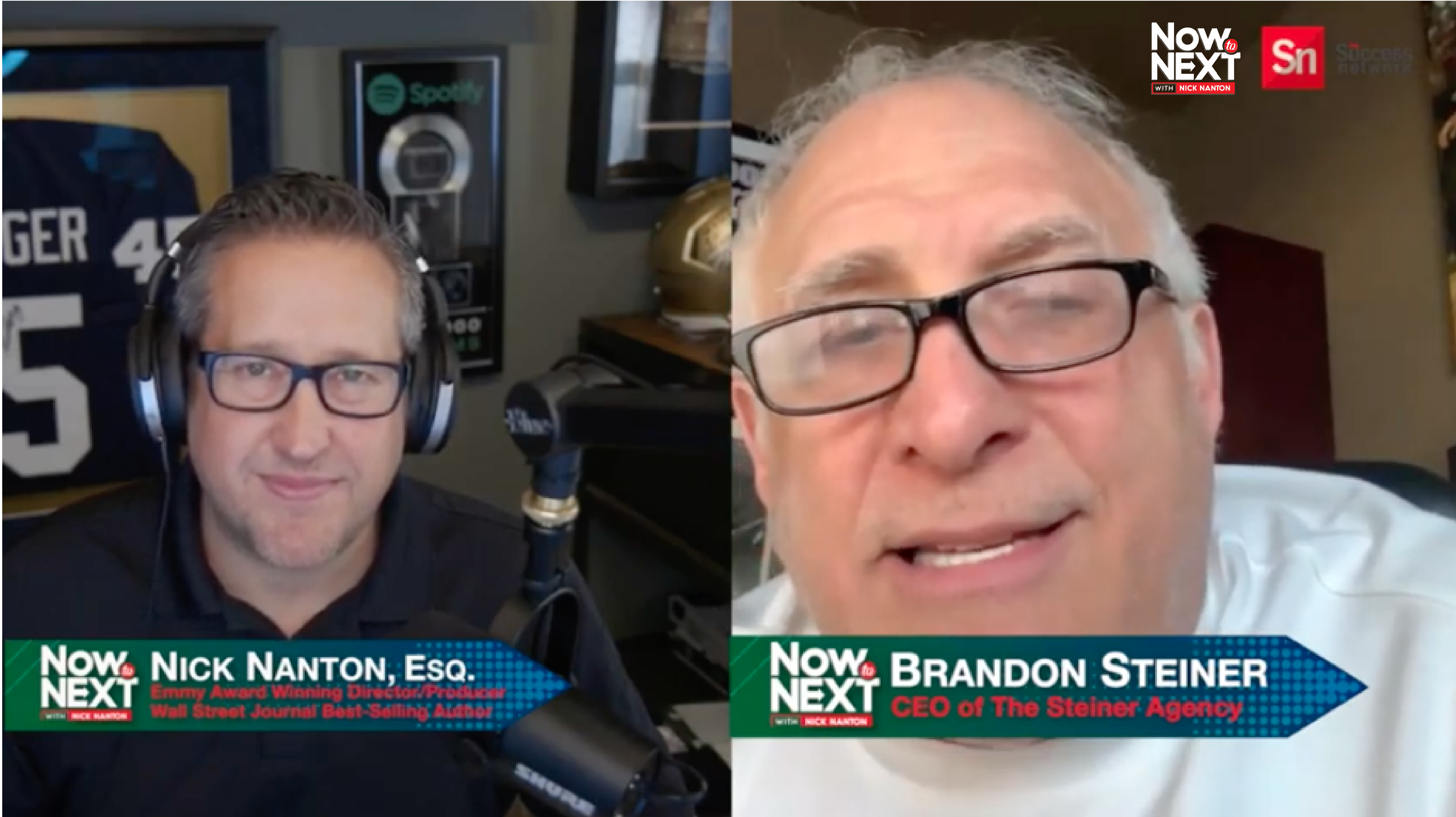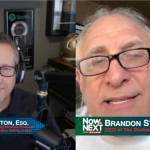What can I do for customers that they cannot do for themselves? That’s the question Brandon Steiner kept asking.
Brandon Steiner is an author, speaker, and founder of Steiner Sports, a $50 million sports marketing and memorabilia company and the most successful of its kind. Brandon has applied the above question to work with some of the world’s most prominent athletes and brands.
Widely known for having bought the old Yankee Stadium, Brandon Steiner is also the founder and CEO of CollectibleXchange, where fans can buy and sell game-used and autographed sports memorabilia.
Brandon joined me on Now to Next to share stories from his life and third book, Living on Purpose.
See Challenging Circumstances as an Opportunity
Brandon was born in 1959 in Flatbush, Brooklyn. His family was impoverished, but he didn’t think much of it until he was 10 or 11 years old when his fifth-grade teacher handed Brandon an envelope of money.
The teacher explained they’d taken up a collection so Brandon could buy some clothes. Starting to feel humiliated, Brandon asked, “How do you know I need clothes?”
“Because you’ve been wearing the same pants for three weeks in a row.”
“How do you know that?”
“You have a rip in your right knee.”
At home, Brandon’s mother insisted he return the money, which he did. However, now that he was aware of his circumstances, he decided to take control and get a job.
That Saturday morning, he spent that whole day up and down Kings Highway until he found Freddy the Fruit Man, who offered him a job stocking fresh fruits. Brandon worked Saturdays at first and then added afternoons after school.
Brandon was able to see his challenging circumstances as an opportunity.
Stop Selling. Start Serving and Solving.
After a couple of years working Saturdays and after school, Brandon wanted work that gave him more free time. His mother suggested a paper route. He could work mornings and only needed to collect money one night a week.
When he got to the newspaper office to inquire about a position, they’d just launched a competition. The delivery person to sign up the most new customers would win a box of chocolates. Brandon imagined himself carrying that box of chocolates home to his mom and, determined to win it, started knocking on doors.
After a full afternoon of door-knocking, he got nothing.
He returned home, defeated, an excuse machine. He told his mom they needed a better neighborhood, and everyone here was cheap—highlighting it with the story of the 80-year-old woman who got the paper every day but would rather go down to the shop to get it herself than pay his tip.
His mom sat him down and said he had to stop selling. She told him to start serving and solving.
Reinvigorated, Brandon went back to the 80-year-old woman’s house and knocked on her door. Brandon told her she could get her paper herself, but what about in the rain and snow? She didn’t need to go out in that weather. He also offered to bring her milk and bagels every Wednesday and Sunday and make himself available to get her other things she might need. She was impressed with his service offerings and signed up for the paper. She even told her friends.
What Brandon didn’t know is how many people in the neighborhood she knew. He went from 29 subscribers to 199. That early lesson in solution-based selling stuck with him.
Solving One Problem After Another
After college, Brandon got a lucky break to work as the general manager for the 1984 launch of the Hard Rock Café on 57th Street in New York (now in Times Square). There, he met several pro athletes, including Bobby Valentine. Together, they turned a little dive bar in Connecticut into an upscale sports bar with a Las Vegas scoreboard and multiple TV’s that is now Bobby V’s Restaurant and Sports Bar.
After the success of Bobby V’s, Brandon consulted with teams to launch sports bars across the country. During this time, he also debuted Steiner Sports with $4,000 from savings.
The idea he started with was simple. Brandon wanted to pair athletes with businesses that needed to draw customers. He sent out thousands of letters to athletes. The letter offered his services to build their brand and included a survey about their hobbies and preferences. Very few inquired about his branding services, but a good percentage returned the survey. He now knew which players liked orange juice and which had ACL injuries.
Brandon used the surveys to create a database and began connecting businesses with specific athletes who were already fans of their product. He helped businesses and athletes collaborate based on shared interests.
A Piece of Yankee Stadium
In 1991, his sports marketing business made money for the companies and athletes, but it wasn’t working as well for Brandon and his family. He was working long hours with minimal profits. So, as the threat of packing it in and getting a job working for someone else loomed closer, he had the idea to sell collectibles at each promotional event to improve his margin.
As he pursued this idea, Brandon realized there was a problem with fraudulent collectibles. He wanted to do right by the industry, especially the fans. He wanted to collaborate with sports teams directly to protect fans from counterfeits, so he started reaching out to the teams. After many doors were slammed in his face, he got a meeting with the Yankees.
The Yankees were interested in protecting their fans from counterfeit merchandise and decided to work with Brandon. This was also around the time when the team knew they’d be moving to a new stadium. Brandon and Randy Levine talked for a long time and, in addition to a system of authenticating collectibles, they came up with a plan to get the old stadium into the hands of fans.
Four years later, the Yankees kept their word, and Brandon purchased the old Yankee Stadium for 18.5 million dollars. After a long, winding process, he was able to have it carefully deconstructed into hundreds of thousands of pieces. Brandon made it possible for Yankee fans to have a chance to buy and keep part of the old stadium as mementos.
Since then, so many teams have used Brandon’s system and process to formulate authentication systems to make sure their fans are receiving real memorabilia. And Brandon has gone on to work with teams to sell pieces of stadiums that were being taken down to make sure that fans would get the opportunity to own a piece of their favorite team’s history, most recently pieces of the Carrier Dome in Syracuse when the roof was replaced.
Preserving Legacies
Some people don’t understand the allure of collecting sports memorabilia. To Brandon, collecting is all about remembering some of the greatest moments and athletes in sports history. It’s preserving legacies! While the value of a collectible may go up and down over the years, it’s the accomplishments of the athletes who wore those cleats during an amazing game that never fade. These achievements deserve to be recognized in more than a record book.
It’s the fans that keep the memories alive and even internalize them too. There can be a lot of motivation within memorabilia. For a kid who’s small and doesn’t fit the typical athlete build, seeing a signed Rudy helmet (there is one that lives in my office, that Brandon pointed out) could give them a world of inspiration and belief that maybe they too can break the mold. Collecting is about a whole lot more than just “owning stuff.”
How To Be Better At Life
Brandon started working on his third book around age 50. He had realized he hadn’t prepared for success and thought others probably hadn’t either. He always thought he’d be successful, but never planned for what he was going to do after achieving success. Brandon thought about things he wanted to do better, like being a better dad and husband, and sought mentors to help him master other areas of his life. He jokes, “I’m definitely good at making money, I suck at everything else…I want to be really good at life, I want to be better at life.”
So inside his newest book, Living on Purpose: Stories about Faith, Fortune, and Fitness That Will Lead You to an Extraordinary Life, Brandon provides a lot of great nuggets of wisdom on how to be better at all parts of your life. Your career, faith, health, etc. all work together to create your life. Throughout the book, Brandon shows the reader what he did to improve in every area. It’s about helping people and showing them the possibilities in every section in life, not telling people what they are supposed to do.
Brandon is also the author of The Business Playbook and You’ve Got to Have Balls. And you can learn more about him by watching or listening to our full “Now to Next” episode on YouTube or your favorite podcasting platform. And, as always, you can direct any questions you have to me too.

